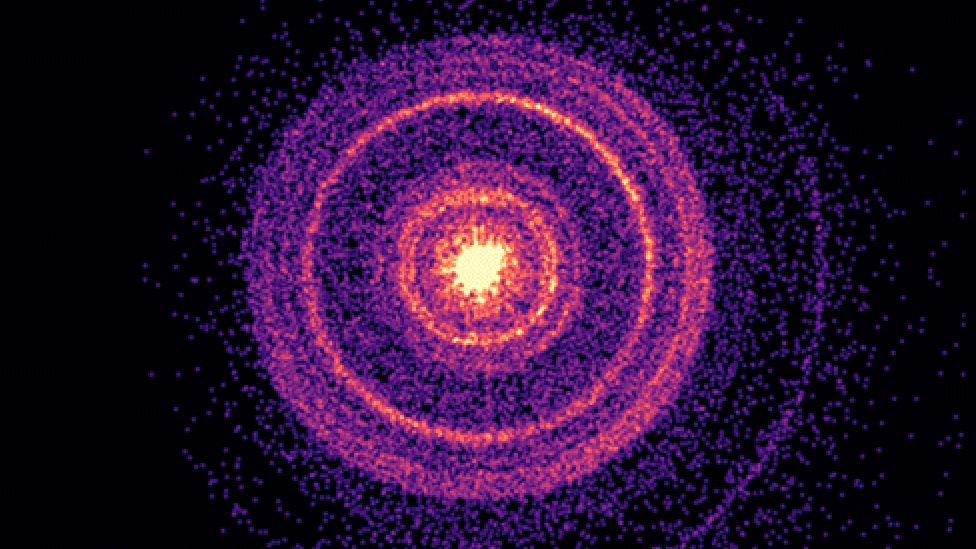ARTICLE AD BOX
 Image source, NASA/Swift/A. Beardmore (University of Leicester)
Image source, NASA/Swift/A. Beardmore (University of Leicester)
Satellites captured images of how the gamma blast lit up dust rings in space
Scientists have revealed how Nasa satellites detected the brightest gamma ray explosion in space.
The gamma-ray burst (GRB) occurred two billion light-years from Earth and illuminated much of the galaxy.
Images of the rare and powerful cosmic phenomenon show a halo and "bullseye" like shapes.
Experts, including academics from the University of Leicester, say the GRB was 10 times brighter than any other previously detected.
They have released detailed analysis of the powerful explosion that was spotted on 9 October, 2022.
The blast was officially named GRB 221009A but has been nicknamed the BOAT - Brightest Of All Time - by those working on a mission Nasa calls Swift.
Image source, ESA/XMM-Newton/M. Rigoselli
Image caption,The images captured have shown unprecedented details of GRBs
X-ray astronomer Dr Phil Evans, who leads the University of Leicester's involvement in Swift, said: "We were really lucky to see something like this. We estimate that events this bright occur roughly once every thousand years.
"By studying the evolution of this astonishingly bright GRB in great detail, we can learn a lot about the physics of a blast wave.
"Just like slow-mo cameras reveal details about movement, breaking our data into small time pieces allows us to see how the GRB changes and learn more."
The Swift team said its Neil Gehrels Swift Observatory, a satellite telescope designed to study GRBs from space, was initially unable to observe the burst because the Earth was obstructing its view.
However, 55 minutes later, when the satellite's orbit allowed it to have a clear view of the GRB, its systems successfully detected it and created images of it.
What are gamma ray bursts?
- Gamma ray bursts are the most violent explosions in the Universe, releasing more energy than the Sun would in 10 billion years
- They result from cataclysmic supernova explosions as massive stars die
- The first GRB was discovered in the late 1960s by a satellite looking for Soviet violations of the nuclear test ban treaty, and since then thousands have been seen by different satellites
Source: University of Leicester
Dr Andy Beadmore, who is also part of the Swift team at the University of Leicester, said: "These patterns are not just beautiful but are also useful scientifically.
"We're seeing a significant amount of dust in our galaxy being lit up by the intense burst of light from the GRB - two billion light years away - like a torch shining through a cloud.
"This lets us study its nature and composition, which was found to extend to large distances from the Sun.
"The brightness of this GRB means that we can collect much better data than normal, and so move beyond simple models of the GRB physics that we normally use - they just can't explain these data."
'Beautiful halo'
Dr Evans adds: "Even after 18 years of operation, Swift can still surprise us with something unexpected, awesome, and scientifically powerful, and it can still challenge us.
"Those dust rings may look pretty but they gave us some headaches, they really complicated the data analysis.
"Even with those complications, though, this event gives us an opportunity to study a GRB in unprecedented detail.
"Then there's the beautiful dust halo that Andy discovered.
"This is caused by massive clouds of dust in our galaxy - but it's the light from the GRB, around two billion light years away - that's actually revealed those clouds to us.
"Now, we can measure their distance and their composition using this GRB 'backlight'.
"This discovery is a testament to the power of careful observation and the potential of serendipitous discoveries.
"I'm thrilled that our team was able to contribute to our understanding of the Universe in such a meaningful way."
Follow BBC East Midlands on Facebook, on Twitter, or on Instagram. Send your story ideas to eastmidsnews@bbc.co.uk.
Related Internet Links
The BBC is not responsible for the content of external sites.

 2 years ago
62
2 years ago
62








 English (US) ·
English (US) ·